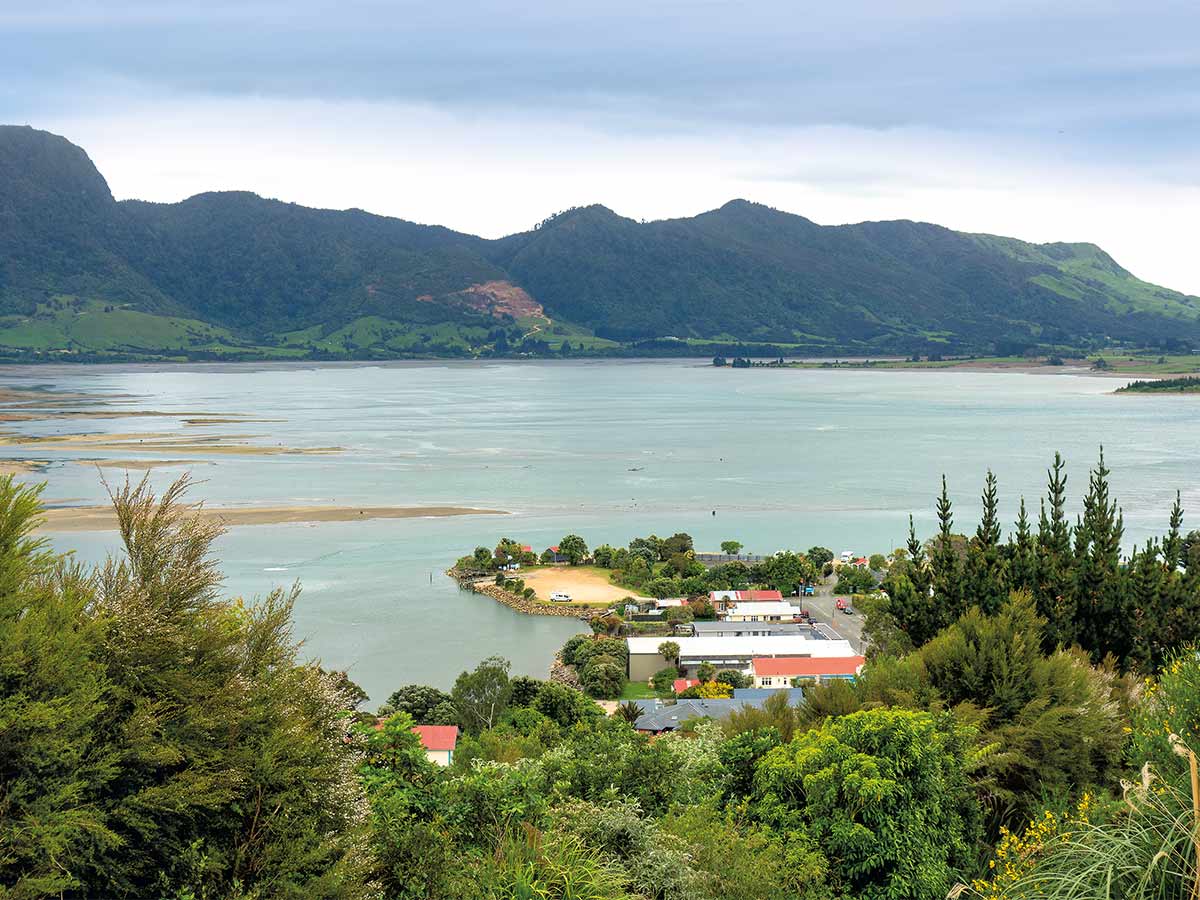As a former resident of the surrounding hinterland, Paul Owen revisits Collingwood and finds the town at the western end of Golden Bay is just as resilient and vibrant as he remembers it
In his book Civilisation: Twenty Places on the Edge of the World, author Steve Braunias calls Collingwood “the loneliest town in the world – beautiful and deserted – the end of the line.”
The rest of his commentary is based on a Saturday night spent in the Collingwood Tavern, followed by a walk down the deserted main street of the town at the western edge of Golden Bay the following morning. It’s like Braunias took a tiny mental snapshot of the town and blew it up to become a pixelated view short on resolution and focus. In my opinion, he got a little too keen to emphasise his ‘edge of the world’ angle.
For Collingwood is far from lonely, as it’s the hub of several more isolated settlements that surround it. Pākawau, Pūponga, Mangarākau, Rockville, Ferntown, Tukurua, Bainham, Parapara, and Milnthorpe are all in the orbit of a town that once had its own newspaper and was considered a worthy contender in the early 1860s to become the capital of this country as a more central replacement for Auckland. In 1865, Wellington got the nod instead.
People from those far-flung places further afield come to Collingwood’s On the Spot General Store to stock up, to have a meal at Tinky’s hospitable tavern, to breakfast and sip a turmeric-fragrant coffee at the Courthouse Café, and to fill up their cars or get them repaired at NV Miller Ltd, the town’s long-surviving family garage, now in its third generation of management. Add those locals to the hundreds of visitors to Collingwood on any given day, and you have a town that punches far above its population of 300 residents.
Proof of the appeal of the town to RV tourists can be found in the number of campgrounds either in attractive parts of the surrounding area or smack in the middle of the town, a short stumbling distance from the tavern. Collingwood Holiday Park is a recently refurbished facility located at the river end of the town’s main street, while there’s also the option of beachside campgrounds at Pākawau, Pūponga, and Tukurua, each offering instant access to the spectacular Golden Bay coastline, and the community of artists and craftspeople who live around it.
The mother of civilisation
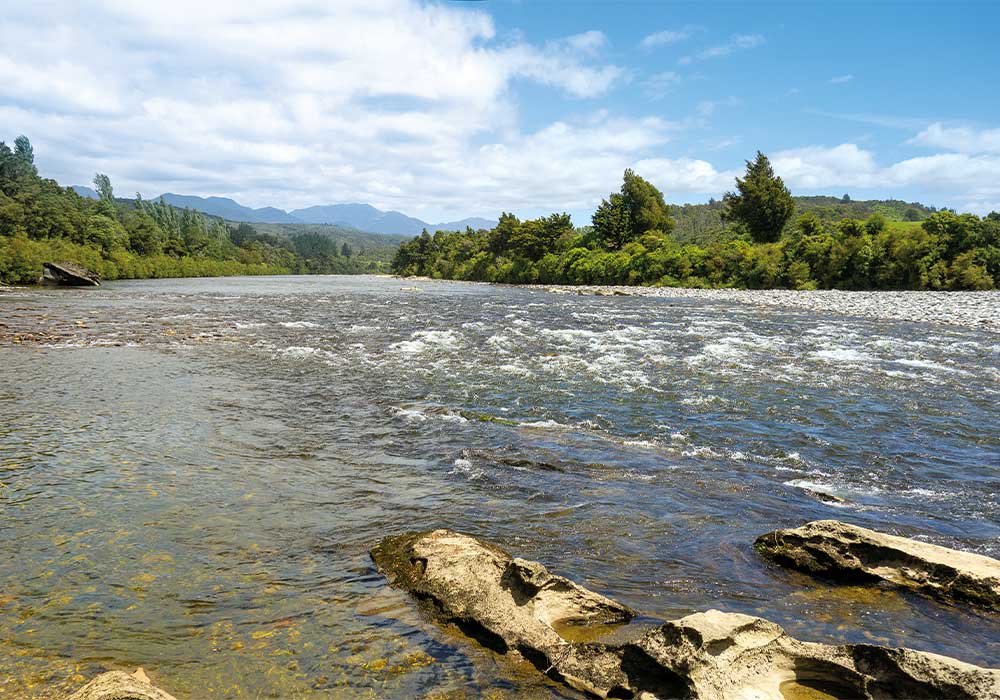
Braunias chose Takaka Hill, a serpentine and elevated 25km stretch of State Highway 60 that’s infamous for its ability to purge motion-sensitive stomachs, as his defining feature of Collingwood. That’s a memorable motoring experience that challenges all who visit Mohua/Golden Bay and not just those who carry on past the sparkling glory of Te Waikoropupū Springs to explore the wilder western part of the region. For me, the defining natural feature of Collingwood is the Aorere River. For centuries, it has washed riches down from the surrounding mountains to the town located at its mouth. The treasures include gold, coal, kai whenua, firewood, and the silt-enriched river terraces that are the foundation of the surrounding farming industry. The extremely high annual rainfall that occurs at the head of the Aorere Valley moderates markedly as the river flows north to the township. It can often be pouring down at Browns Hut at the start of the Heaphy Track, 40km south of Collingwood, and mild and sunny at the river mouth.
The nutrients wash through the river catchment settle when they reach the bay, the flow interrupted by Farewell Spit, a natural sand peninsula formed by the strong four-knot Tasman Sea current that surges up the west coast of the South Island. The bay experiences remarkable tides, rising and falling five to six metres twice a day, providing seabirds and waders access to the rich layer of multi-fauna that feeds on these nutrients. Ruataniwha Estuary, adjacent to the little peninsula that protected Collingwood’s once-active port, might look muddy and unappealing at low tide but it’s a healthy natural ecosystem that makes the town one of the best places to view birdlife in New Zealand.
New Zealand’s oldest 4WD adventure tour
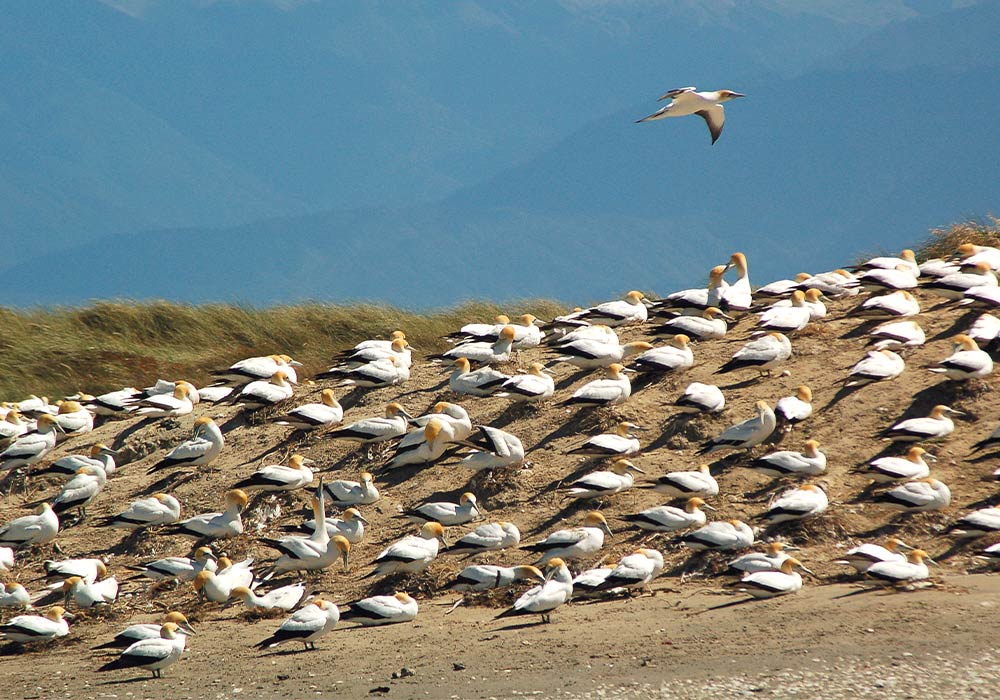
Taking a tour along Farewell Spit will multiply the birdlife-watching opportunities by a factor of roughly one thousand. The spit is 30km in length, and the more sheltered side has wide tidal silt flats that give sustenance to thousands of godwits, spoonbills, oystercatchers, and up to 90 species of other birds. At the far eastern end of the feature, another shorter sandspit extends into Golden Bay, creating a haven for nesting gannets. Such is the protection afforded by the deeper water surrounding this area and the strength of the prevailing winds to assist take-offs that the Australasian gannet colony at the end of Farewell Spit is the only one located at sea level.
“This creates an excellent opportunity to watch the interaction of parent birds and their young,” says Paddy Gillooly, owner/operator of Farewell Spit Tours.
Paddy, who first joined the company while following in the footsteps of his father Denny and his uncle Brian in 1986, says that every tour is different, and the driver never knows what wildlife may be encountered.
“There have been stories in the (70-year) history of the company of drivers being bitten by sharks when they grabbed them by their tails to better show them off, thinking they had expired.
“We sometimes get to see giant squid washed up on the shore and one of the rarest encounters was with a Loggerhead turtle, which I presume had come ashore to lay her eggs.
“I’d like to think that on a starry moonlit night on the Spit, hundreds of young turtles emerged and scrambled their way to the water.”
Seals are often encountered on the tour, and not just those of the comparatively harmless furry variety.
“We usually see a leopard seal about once every three days.”
Farewell Spit Tours offers three experiences: a Farewell Spit tour that takes in Cape Farewell, Pillar Point, and Fossil Point as well; a Gannet Colony tour restricted to 20 people to limit disruption to the colony; and a shorter Wader Watch tour that takes two hours instead of the six-and-a-half hours of the former two. The longer tours leave from the former Collingwood Motors building on the main street of the town, while the Wader Watch leaves from Pūponga, the little settlement at the base of the Spit. Tides dictate the departure times.
Isolation encourages innovation
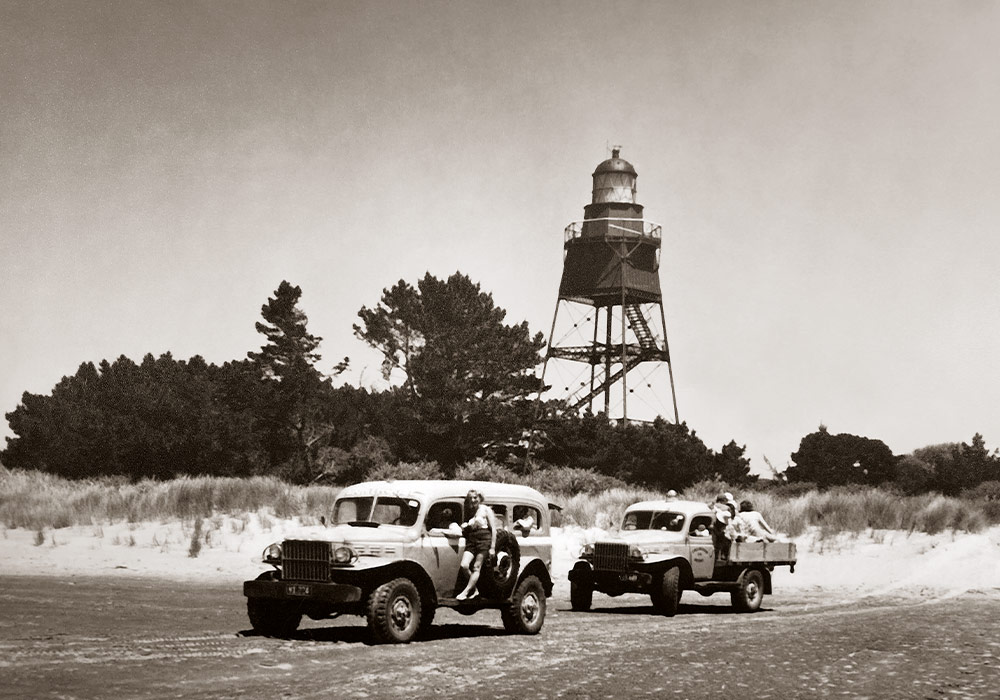
Back in the days when I lived near Collingwood, Linley Butler, then living as a solo mum on Gibbs Road, started and ran a mail order company called HealthPost from a small office in her home. These days, HealthPost is a Collingwood-based machine, owned and run by the Butler family and employing 70 people in the Golden Bay town and a further 20 up in Auckland. It recently acquired two companies across the Tasman to kick off its push into the Australian health product online sales market.
The company is owned by Linley’s former husband, Peter, and run by their children, Abel and Lucy. Peter Butler also has Forest Herbs Research, which undertakes research into the medicinal uses of native plants and grows a plantation of high-activity horopito, which forms the basis of their anti-fungal and anti-yeast Kolorex range of products. These are sold mainly in Europe and North America but surprisingly Vietnam and South Africa are also keen on Kolorex.
Peter’s passion began when he and Linley first bought an isolated parcel of land that bordered what’s now Kahurangi National Park. He then had to find a viable way of making a living while residing virtually within the rainforest that borders the Kaituna River, one of the tributaries of the Aorere.
The journey of the Butler family is one of many stories about people who moved into the Collingwood area because it offered land at prices that they could afford then and became successful in establishing viable livelihoods.
The Butlers have also gone into partnership with the Department of Conservation and Mohua tangata whenua to create the HealthPost Nature Trust, and Peter has financed some of the other efforts of volunteer groups in the area such as the Kaituna Track Restoration Society and those nursing a substantial wetland back to becoming a healthy ecosystem again in Mangarākau. He has set aside a corner of his horopito farm that overlooks the Kaituna River as a picnic spot halfway between Collingwood and the historic Bainham store. It’s identified by a wooden sign engraved Kaituna River followed by the smiley face icon.
Conservation on TV
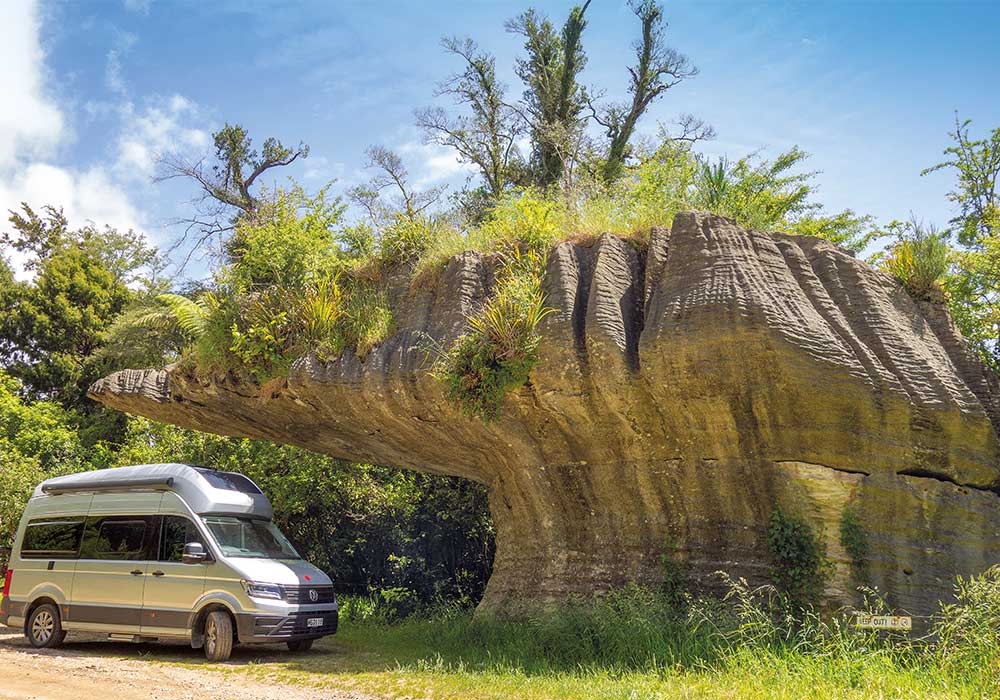
“This is the kind of TV that I most like to watch at night,” says HealthPost Nature Trust volunteer, Marian Milne, as she collects sim cards from the CCTV cameras dotted around the seabird sanctuary that the trust has established near Cape Farewell. Some of the cameras are located near the stainless-steel predator-resistant fence that separates the sanctuary from the surrounding DOC land to check if any pests are trying to get inside. Other shoot footage is of the entrances to the many underground nest sites to identify if any birds are beginning to take up residence there.
The project targets the fluttering shearwater (pakahā) and the sooty shearwater a.k.a. the muttonbird (tītī). The trust also hopes to attract diving petrels (kuaka) to nest at the site.
“The aim is to restore mainland colonies of these birds,” says trust volunteer, Rob Jones.
A retired farmer residing on the Waimea plains over Takaka Hill, Rob regularly makes the arduous journey to Cape Farewell to add his effort to create a mainland sanctuary for these vulnerable seabirds. It’ll be quite a milestone for the trust when the birds they hatched at the sanctuary a year ago return to lay eggs of their own. Let’s hope these widely travelled aviators find the Collingwood area as irresistible as I do.
Five places to stay in Collingwood
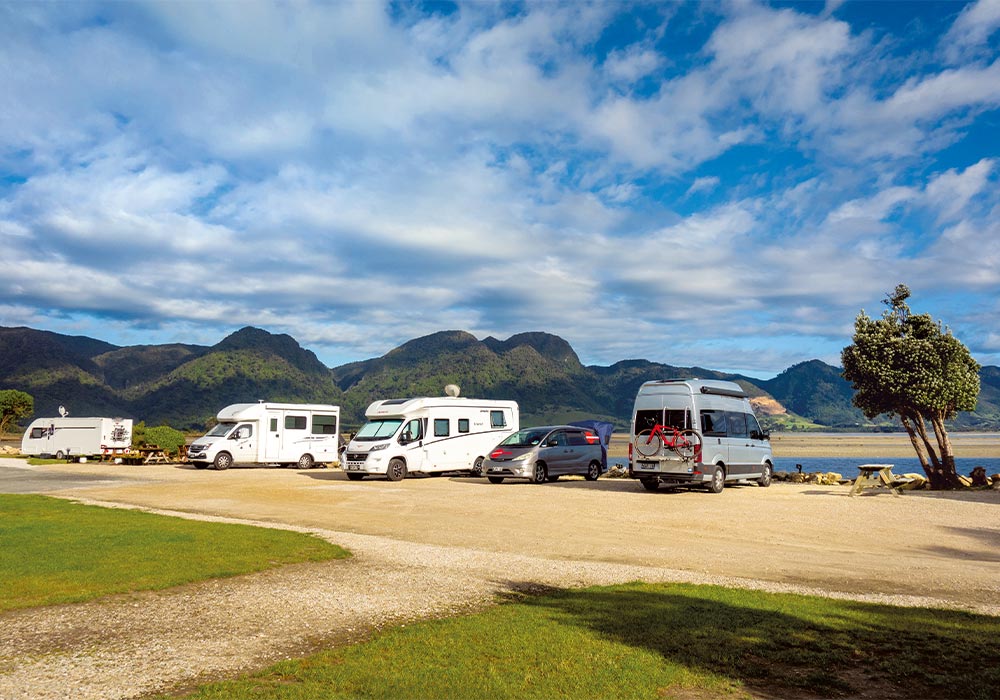
- Collingwood Holiday Park (CHP): Perfectly located on the mouth of the Aorere but beware of the limited 2pm–6pm office hours. Late fees apply.
- Pākawau Beach Camp: Enjoy beachfront camping here, with competitively priced powered sites. Relax to the sound of waves, amazing sunsets and sunrises, and the Old School Cafe Restuarant across the road.
- Farewell Gardens Holiday Park: It has cabins and campsites available at Pūponga where you can watch black swans foraging for tasty morsels on the seabed.
- Golden Bay Holiday Park: Located at the end of Tukurua Road, 10km east of Collingwood. The famous Mussel Inn at Onekaka is a further 5km east.
- Zatori: Collingwood’s former Joan Whiting Memorial Hospital has been transformed into a wedding/event venue with accommodation for 28 people. Excellent views.
Five must-dos in Collingwood

- Take the Farewell Spit tour: An iconic Kiwi experience that has wowed families for several generations.
- Visit the Aorere Goldfields: Several walking tracks take you to what remains of Bedstead Gully and the huge Ballroom Cave where the miners held dances.
- Walk the coastline from Collingwood to Milnthorpe: There’s hardly a dwelling in sight and plenty of opportunities to chill out and enjoy the seascape.
- Soak in the history at the Aorere Heritage Center: Located on Collingwood’s main street, this is full of info and historic photos, including those of the four fires that almost razed the town.
- Explore the coasts north and west of the town: Scenic treasures await those who drive to Wharariki Beach, Cape Farewell, Kaihoka Lakes, Anatori River, and Mangarākau.

